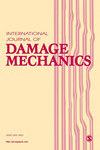通过 DIC 结合 CT 探索沥青混合料的冻融破坏分布
IF 3.9
2区 工程技术
Q2 MATERIALS SCIENCE, MULTIDISCIPLINARY
引用次数: 0
摘要
露天分级摩擦路面(OGFC)由于其丰富的空隙结构和暴露于环境中的特性,极易受到荷载和堵塞等环境影响。特别是在寒冷地区,冻融(F-T)破坏对 OGFC 不可避免。现有的分析方法无法具体描述材料对荷载或环境的微观反应。因此,本研究将数字图像相关(DIC)与计算机断层扫描(CT)相结合,仔细研究了 OGFC F-T 损伤的复杂过程。主应变和应变能被用来描述 F-T 损伤的过程和分布。此外,还讨论了初始空隙含量和浸泡条件对损伤时空分布的影响。数据表明,F-T 损伤应变的空间分布是不均匀的。在 F-T 循环期间,OGFC 内部的主应变普遍增大,样品的变形逐渐累积。根据应变能增长率的变化,在 18 个 F-T 周期中,F-T 损伤可分为两个阶段,即发展阶段和减速阶段。此外,F-T 破坏的关键部位被确定为与外部相连的空隙末端或集料与沥青砂浆之间的空隙界面。较大的初始空隙含量会增加 OGFC 在 F-T 循环期间的应变以及应变的不均匀性。此外,应变能显著增加,加速了 OGFC F-T 损伤的发展。在部分浸入条件下,由于 F-T 的直接作用,浸入部分具有较大的应变和应变能,而浸入深度的增加会加剧 F-T 损伤。本文章由计算机程序翻译,如有差异,请以英文原文为准。
Exploring freeze-thaw damage distribution of asphalt mixture through DIC in combination with CT
Open graded friction course (OGFC) is highly susceptible to environmental impacts such as load and clogging, due to its rich void structure and exposure to environments. Especially in cold regions, freeze–thaw (F-T) damage is inevitable for OGFC. While the existing analysis methods cannot specifically describe the material's micro-response to load or environment. Therefore, the digital image correlation (DIC) in combination with computed tomography (CT) was applied to closely examine the intricate process of F-T damage of OGFC in this research. Principal strain and strain energy were used to describe the F-T damage process and distribution. In addition, the effects of initial void content and immersion conditions on the temporal and spatial distribution of damage were discussed. The data demonstrated that the spatial distribution of F-T damage strain was uneven. During F-T cycles, the principal strain inside the OGFC during F-T cycles was generally increased, and the deformation of the sample gradually accumulated. According to the strain energy growth rate variation, the F-T damage could be divided into two stages during the 18 F-T cycles, namely, the development stage and the deceleration stage. Moreover, the crucial parts of F-T damage were determined to be at the end of the voids connected with the outside or the void interface between the aggregates and asphalt mortar. The larger initial void content would increase the strain of OGFC during F-T cycles, as well as the inhomogeneity of the strain. Furthermore, the strain energy increased considerably, and the development of F-T damage of OGFC accelerated. Under partial immersion conditions, the immersed part has large strain and strain energy due to the direct effect of F-T, and the increase in immersion depth aggravates the F-T damage.
求助全文
通过发布文献求助,成功后即可免费获取论文全文。
去求助
来源期刊

International Journal of Damage Mechanics
工程技术-材料科学:综合
CiteScore
8.70
自引率
26.20%
发文量
48
审稿时长
5.4 months
期刊介绍:
Featuring original, peer-reviewed papers by leading specialists from around the world, the International Journal of Damage Mechanics covers new developments in the science and engineering of fracture and damage mechanics.
Devoted to the prompt publication of original papers reporting the results of experimental or theoretical work on any aspect of research in the mechanics of fracture and damage assessment, the journal provides an effective mechanism to disseminate information not only within the research community but also between the reseach laboratory and industrial design department.
The journal also promotes and contributes to development of the concept of damage mechanics. This journal is a member of the Committee on Publication Ethics (COPE).
 求助内容:
求助内容: 应助结果提醒方式:
应助结果提醒方式:


